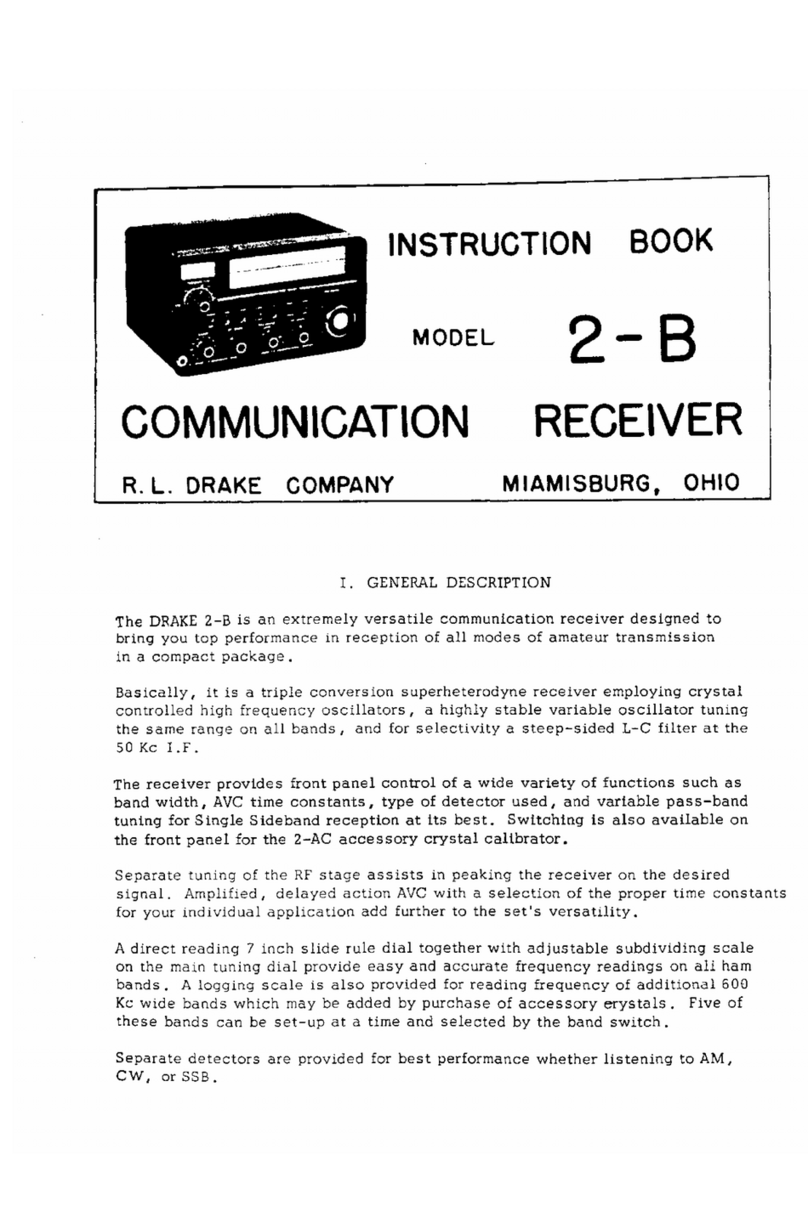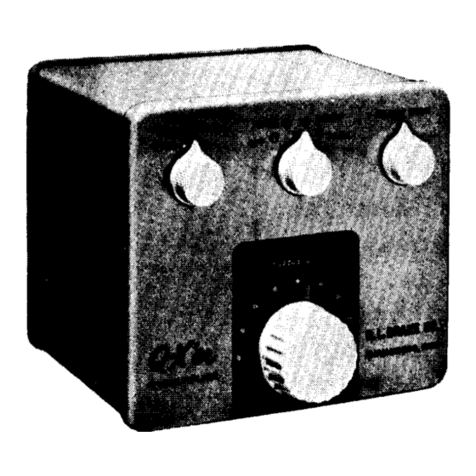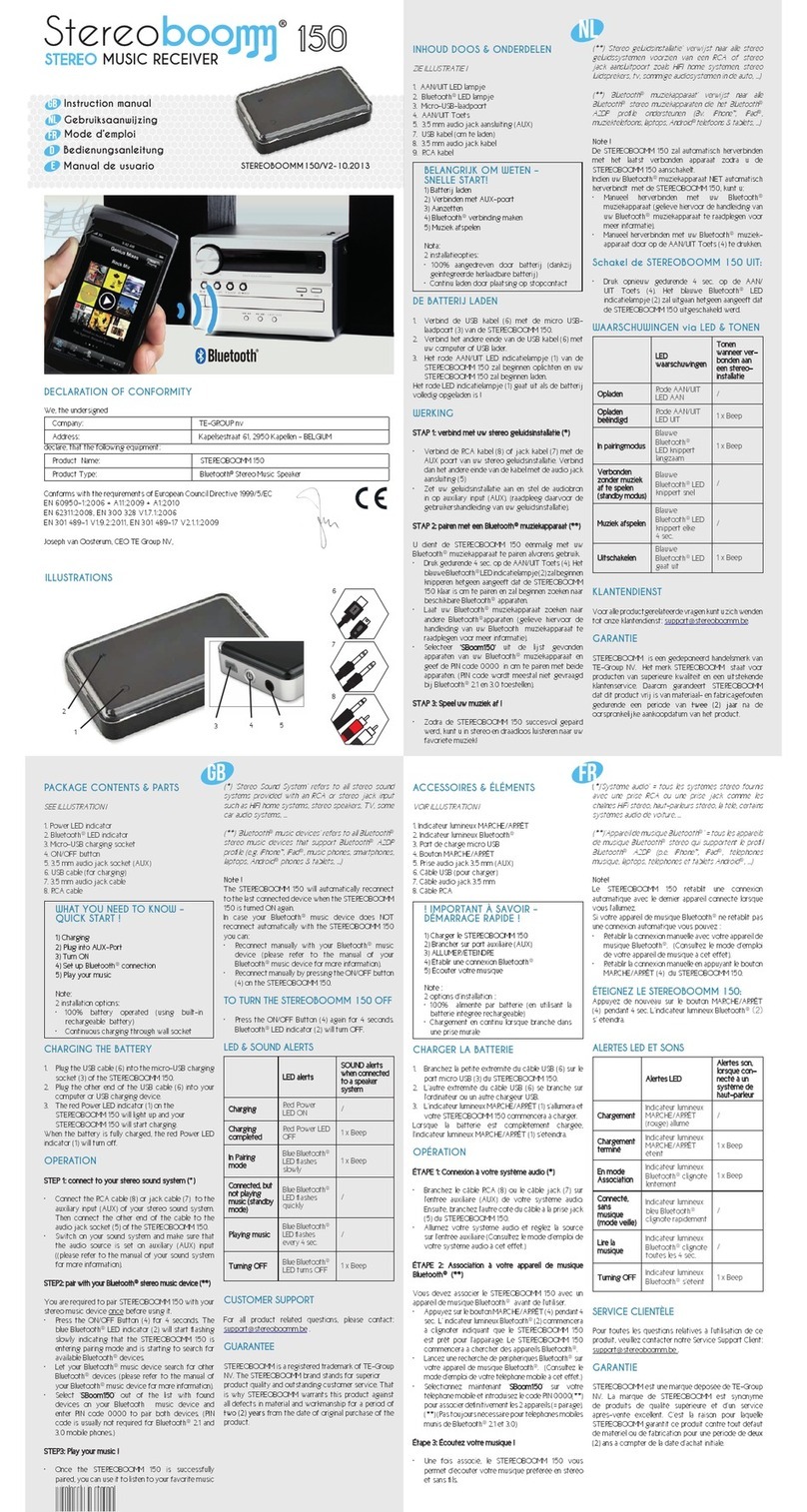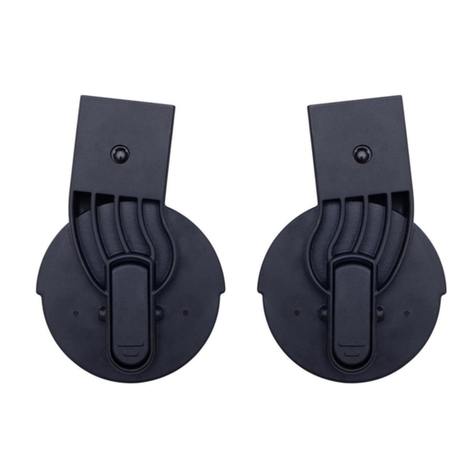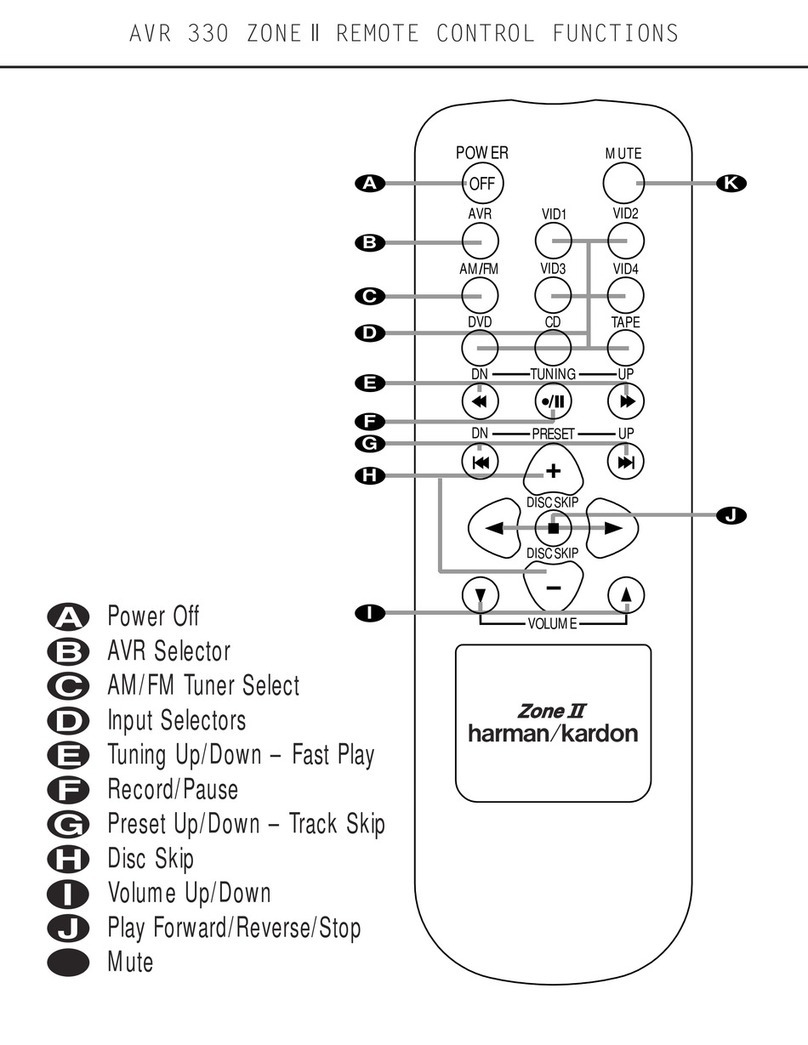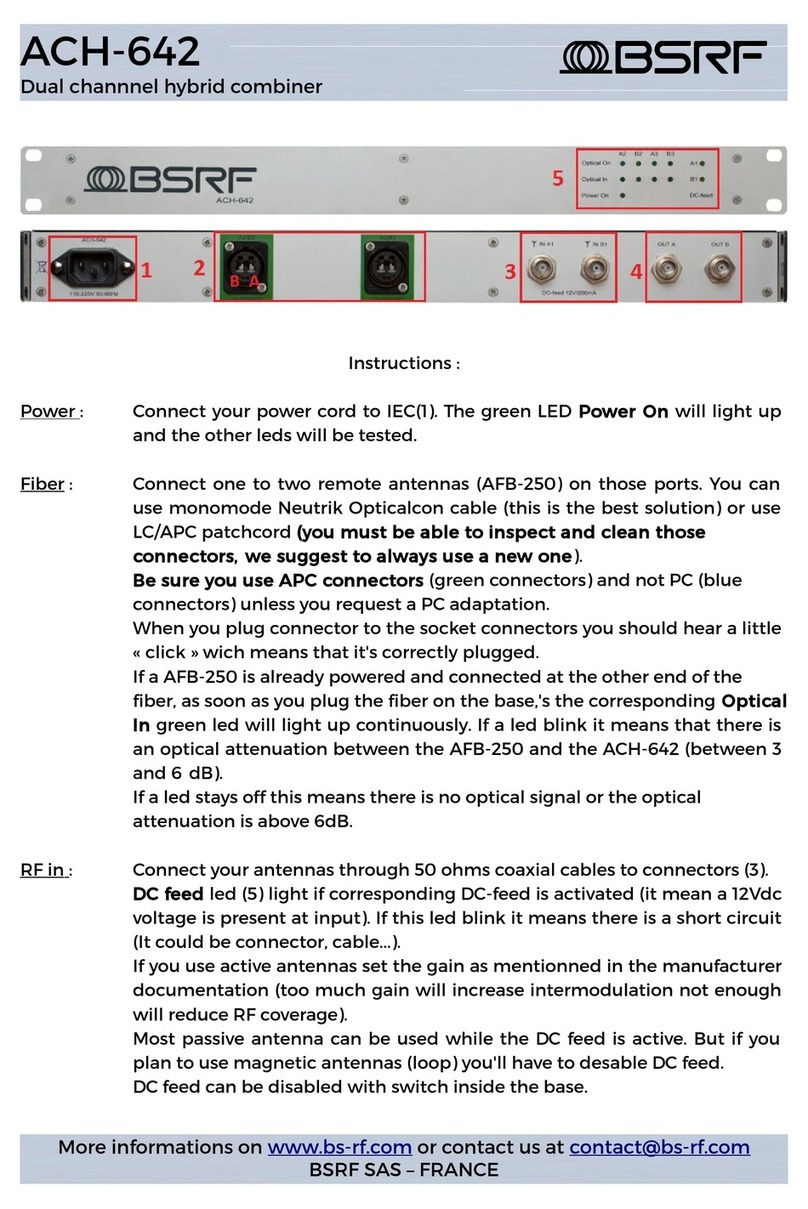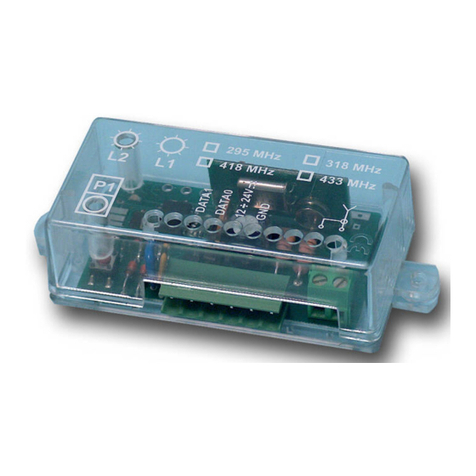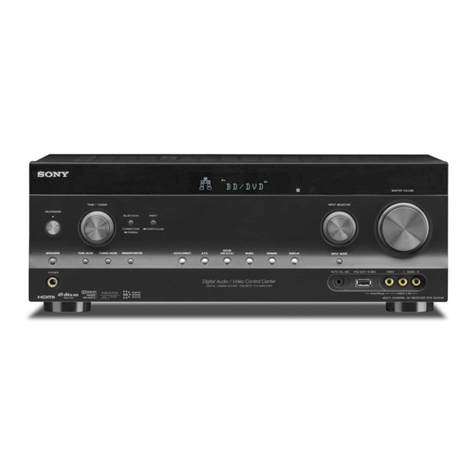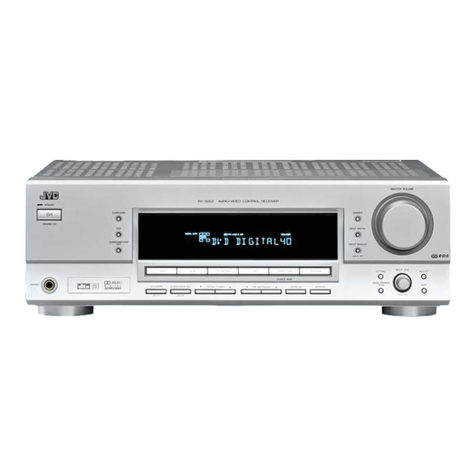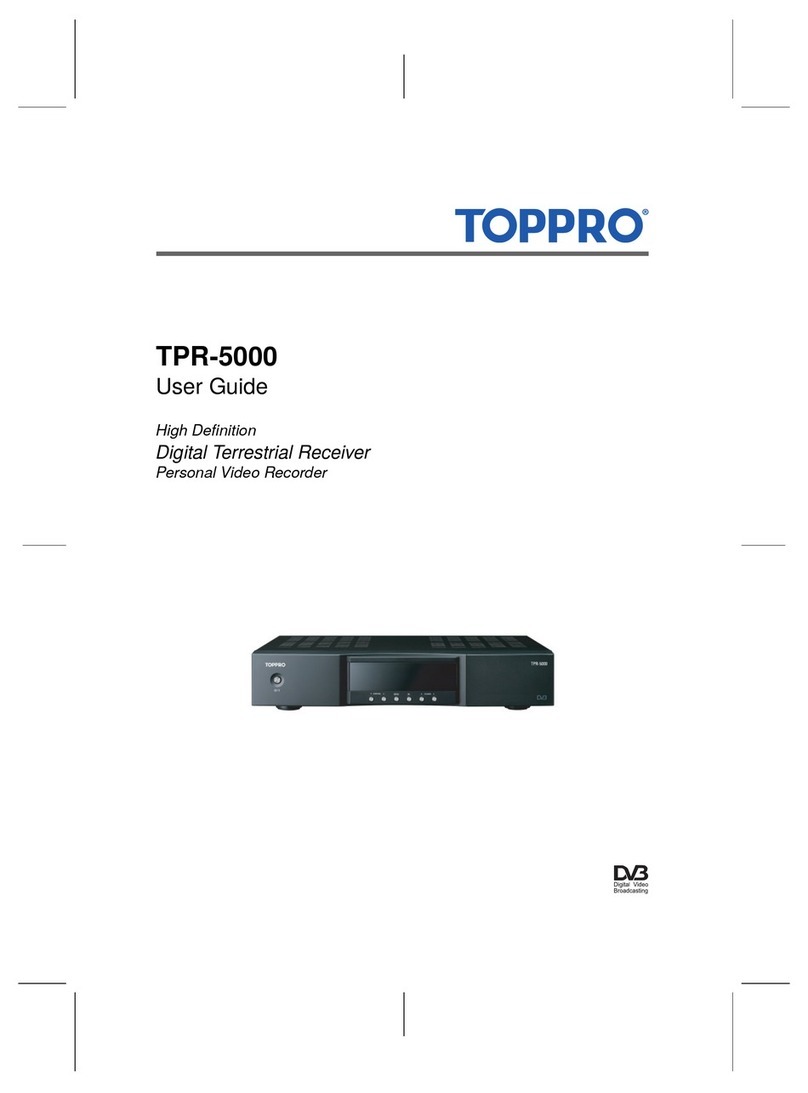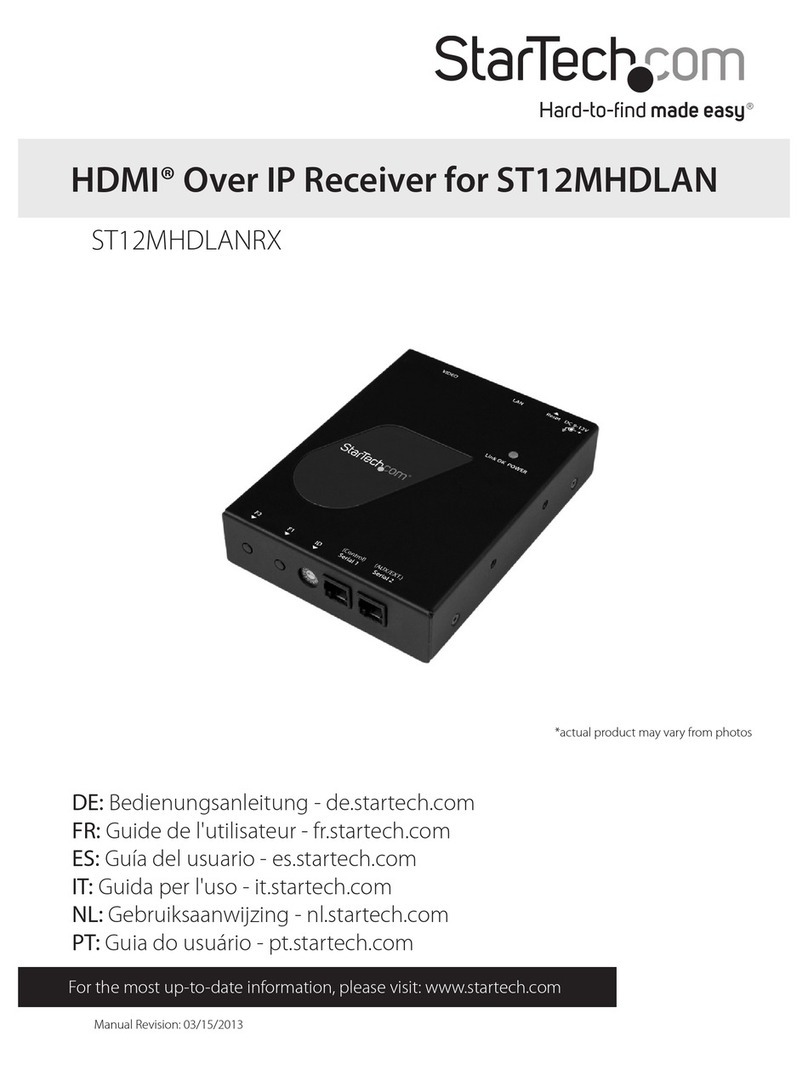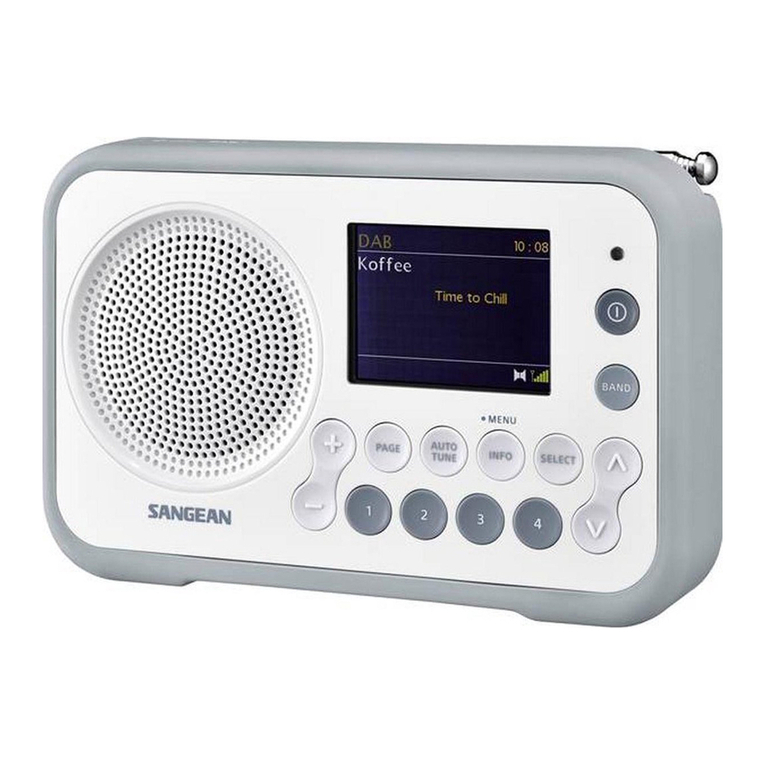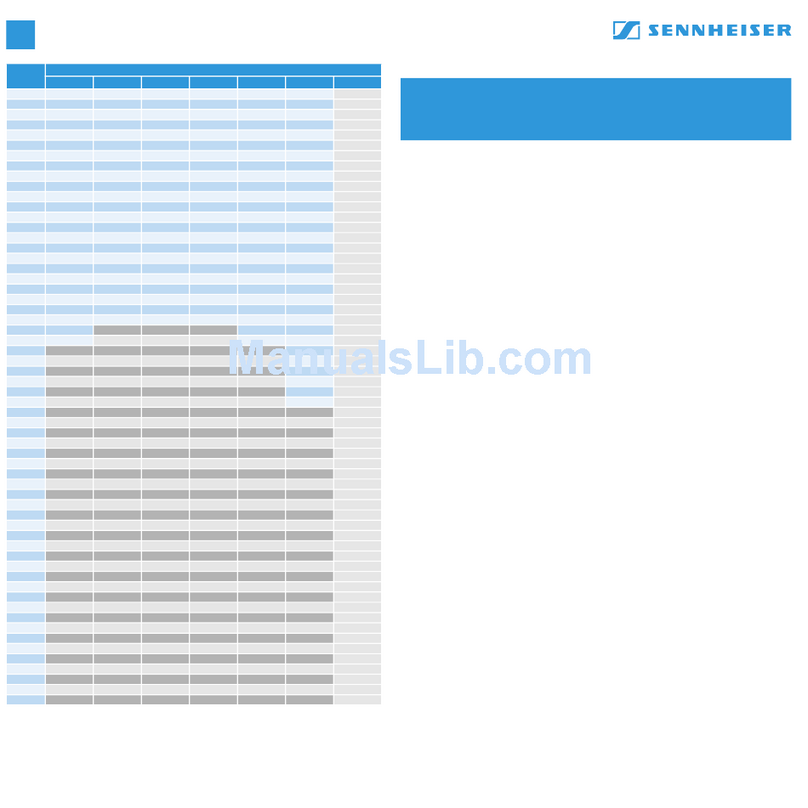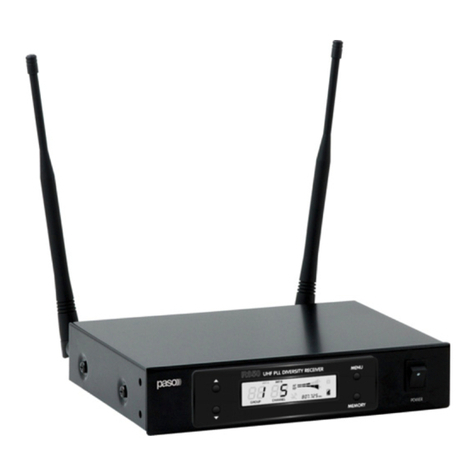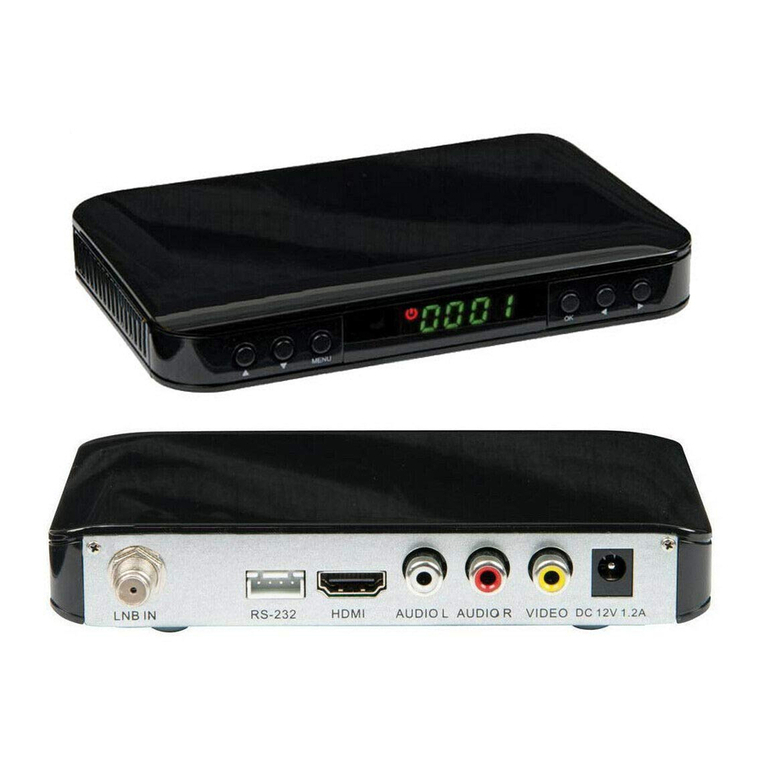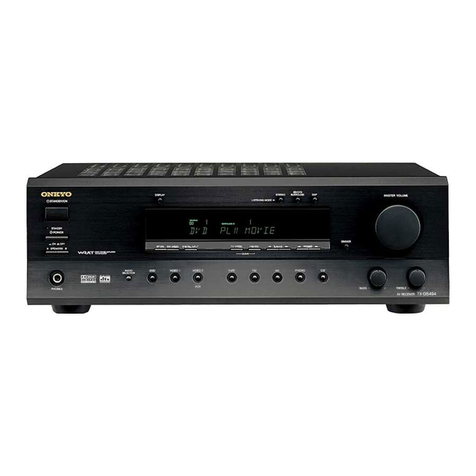R.L.DRAKE R-4A User manual


TABLE OF CONTENTS
General Specifications
3
I General Description
5
II Installation Instructions
A.
Unpacking
6
B. Location
6
C. Power Requirements
6
D. Antenna Requirements
6
E.
Speaker Requirements
7
F.
Anti-VOX
7
G. Muting
7
III Control Functions
9
A.
Front
9
B. Rear Jacks
11
c.Side Controls
&
Jacks
12
IV Operation
A.
B.
c.
D.
E.
F.
G.
H.
I.
J.
Preliminary Control Settings
Single Sideband or Double Sideband Suppressed
Carrier Reception
C. W. Reception
AM Reception
RTTY Reception
Adjusting Dial Calibration
Noise Blanker Operation
Operation of Notch Control
Accessory Frequency Coverage
Fixed Frequency Operation
13
13
13
14
14
15
15
16
17
20
V Theoryof Operation
21
A*
R. F. Amplifier
21
B. First Mixer and Premixer System
21
c.Second Converter
22
D.
50
KC
I. F. System
22
E. Detector Systems
22
F. Audio Output 24
G.AVC System
24
H.S Meter
24
I. Noise Blanker
25
J.
Crystal Calibrator
25
K.
Power Supply
25
6
13
-l-

VI Service Data
27
A, Removing Top Cover 27
B. Removing Bottom Cover 27
C. Tube Replacement 27
D. Troubleshooting
27
VII Alignment Instructions
A.
B.
c.
D.
E.
F.
G.
H.
I.
J.
Fig.
#
1
Connecting R-4A to TR-4 Transceiver
Fig.
#
2
Viewing Angle Option
Fig.#
3
Rear View
Fig.
#
4
Crystal Freg. Chart
Fig.
#
5
Pre selector Chart
Fig.
#
6
Selectivity C urve s
Fig.
#
7
Notch Curves
Fig.
#
8
Block Dia gram
Fig.
#
9
Voltage Chart
Fig.
#
10
Resistance Chart
Fig.#
11
Top View
Fig.,
#
12
Bottom View
Fig.
#
13
Schematic Diagram
50KC Oscillator Alignment
50KC I. F. Alignment
Crystal Filter and Filter Match Transformer
Alignment
5595 KC Oscillator Alignment
Antenna RF, and Injection Circuit Alignment
100 KC Calibrator Alignment
V.F.O. Adjustment
Notch Filter Alignment
Passband
Tuner Alignment
Bias and S-meter adjustment
CHARTS AND ILLUSTRATIONS
32
32
32
33
33
34
35
35
35
35
36
8
8
12
18
19
23
23
26
28
29
30
31
37
-2-

GENERAL
SPECIFICATIONS
FREQUENCY COVERAGE:
3.5-4.0 MC,
7.0-7.5Mc,
14.0-14.5,
21.0-21.5,
and 28.5-29.0 MC with crystals supplied. Ten accessory crystal sockets
are provided for coverage of any 10 additional 500 KC ranges between 1.5
and 30 MC with the exception of 5.0-6.0 MC.
SELECTIVITY: Drake tunable
passband
filter provides:
.4
KC at 6 DB down and 2.6 KC at 60 DB down
1.2 KC at 6 DB down and 4.8 KC at 60 DB down
2.4 KC at 6 DB down and 8.2 KC at 60 DB down
4.8 KC at 6 DB down and 20 KC at 60 DB down
Selectivity switching is independent of detector and AVC switching.
I. F . FREQUENCIES: First I. F.
-
5645 KC crystal lattice filter; second I.F.
50 KC tunable L/C filter.
STABILITY: Less than 100 cycles after warm up. Less than 100 cycles for 10%
line voltage change.
SENSITIVITY: Less than
.5
uv for 10 DB signal plus noise to noise on all
amateur bands.
MODES OF OPERATION: SSB, CW, AM, RTTY
DIAL
CALIBRATION: Main dial calibrated0 to 500
KC
and500 to 1000
KC
in
5 KC
divisions. Vernier dial calibrated 0to 25 KCin
1 KC
divisions.
CALIBRATION ACCURACY: Better than 1 KC when calibrated at nearest 100
KC point.
AVC: Amplified delayed AVC having slow
(.
75
sec
.) or fast
(.
025 sec.)
discharge; less than 100 microsecond charge. AVC can also be switched
off. 3 DB change in AF output with 60 DB change in RF input.
AUDIO OUTPUT: 1.4 watts max. and .5 watts at AVC threshold.
AUDIO
OUTPUT
IMPEDANCE: 4 ohms and hi impedance for anti-vox.
ANTENNA INPUT: Nominal 52 ohms.
SPURIOUS RESPONSES: Image rejection more than 60 DB. I. F. rejection
more than 60 DB on ham ranges. Internal spurious responses in ham ranges
less than the equivalent 1 uv signal on the antenna.
-3-

TUBES AND SEMICONDUCTORS:
TUBE
12BZ6
12BA6
6HS6
6HS6
12BE6
12BA6
12BA6
2N3394
2
-
2N3394
6EH5
12BA6
12AX 7A
2N706
2N3858
2N3394
lN714
0B2 and lN483A
2
-
lN3194
lN3194
lN270
and
2N3394
2
-
lN483A
lN483A
lN483A
2
-
lN270
FUNCTION
R.F. amp.
100 KC calibrator
1st mixer
Premixer
2nd mixer and xtal oscillator
50 KC I.F.
50 KC I.F.
AVC amp./AVC det.
Audio amp.
Audio output
Noise blanker amp.
Noise blanker amp. /shaper
VFO
VFO buffer
Xtal oscillator
Voltage regulator
Voltage regulator
Power supply rectifiers
Bias rectifier
AM detector
Noise blanker pulse clippers
Noise blanker gate
Switching
Prod. det.
FRONT PANEL CONTROLS: Main tuning, AF gain, RF gain, SSB/CW-AM
with slow AVC, fast AVC, or AVC off, function switch, band
switch,xtal
switch, passband tuning and selectivity, preselector, notch, and head-
phone jack.
REAR AND SIDE JACKS AND CONTROLS: S-meter zero, notch adjust,
antenna jack, speaker jack, mute jack, anti-vox jack,
T4/T4X
injection
jack, accessory power socket,crystal lock socket, xtal/VFO switch,
ground post ,and fuse post.
POWER CONSUMPTION: 60 watts,
120/240
VAC,
50/60
cycles.
DIMENSIONS:
5-l/2”
high,
l0-3/4”
wide, cabinet depth
ll-5/8”,
overall length
12-l/4”,
weight 16 lbs.
-4-

I GENERAL DESCRIPTION
The DRAKE R-4A is an extremely versatile communication receiver de-
signed to bring you every feature desirable for the ultimate in the
reception of all modes of amateur communications.
It provides a linear permeability-tuned solid state VFO with 1 KC
readability, and premixed injection with crystal controlled high frequency
oscillator for stability on all bands. A 100 KC crystal calibrator is built-in.
An improved
passband
tuner/filter with four selectivity positions, and
a built-in notch filter are incorporated to provide the desired selectivity
and interference rejection,and a noise blanker is built-in for elimination
of most noise on CW, SSB and AM.
As supplied, the unit gives complete coverage of 80, 40, 20, and 15
meter bands as well as the 28.5 MC to 29 .O MC portion of 10 meters.
Ten accessory crystal sockets are provided for coverage of other 500
KC frequency ranges between 1.5 and 30 MC such as 160 Meters, MARS
frequencies,WWV, short wave broadcast, etc. These sockets can be
programed to give up to 5 MC of continuous coverage for convenient use
with V. H. F. converters.
The R-4A also includes time proven DRAKE AVC with
fast-attack/slow-
release for SSB or AM and fast-attach fast-release for CW. If desired,
the AVC can be completely disabled for CW reception.
Complete AVC action and accurate S-meter indication can be obtained,
on all modes. A crystal-lattice filter following the first mixer provides
excellent overload characteristics by providing selectivity before gain
producing stages.
When used with our T-4 Reciter, transceive operation may be obtained,
and when used with the T-4X transmitter, either transceive or independent
receive and transmit functions are possible.
-5-

II INSTALLATION INSTRUCTIONS
A.
UNPACKING
Carefully remove your R-4A from the packing carton and examine it closely
for signs of shipping damage. Should any be apparent, notify the delivering
carrier immediately, stating the full extent of the damage.
Fill out and mail the enclosed warranty registration card so that your
warranty will be effective.
Save the packing material. You may need it later for reshipment or storage.
Inspect the packing material closely before putting it away to be sure that
you have not overlooked any accessory hardware.
B. LOCATION
In general the location of the R-4A is not critical. However, care should be
taken to insure that space is allowed around the unit for adequate air
circulation. Extremely hot locations,such as near radiators or heating
units,should be avoided. Do not cover the top of the R-4A with books,
papers, or pieces of equipment,as overheating may result.
c.
POWER REQUIREMENTS
The R-4A is supplied with a dual-primary power transformer and can be
operated from 120 or 240 volt
50/60
cycle AC. As supplied from the factory,
it is wired for 120 volt operation. If 240 volt operation is desired, it will
be necessary to remove the black/yellow and black/green power transformer
primary wires from the terminals to which they are now connected and
connect them together at the unused terminal on the same terminal strip.
It will also be necessary to replace the
.
75 amp fuse supplied with the
unit with a
.4
amp Slo-Blo fuse for adequate protection at the increased
voltage (see schematic diagram).
D.
ANTENNA REQUIREMENTS
The R-4A is designed to give best results when used with an antenna resonant
on the operating frequency and having an impedance from 50 to 75 ohms.
This requirement is most easily met using a center-fed dipole antenna cut
to the desired frequency and fed with
RG58A/U
cable. However, there are
many other antennas which will fulfill this requirement. For a more detailed
de scription on antennas ,we suggest you refer to the ARRL Antenna Book or
The Radio Amateur’s Handbook.
-6-

Antenna connection to the R-4A is provided at the jack on the rear of the
chassis marked ANT.
It is recommended that when the R-4A is used with a transmitter, the trans-
mitting antenna be used; change-over being accomplished by an antenna
relay. This function is providedinternally in our model T-4 and T-4X
Transmitters.
E.
SPEAKER REQUIREMENTS
A good quality 4 ohm speaker should be connected to the jack on the rear
of the chassis marked SPKR. If one lead of the speaker is grounded to its
cabinet, its connection should be to the chassis of the R-4A.
Our accessory speaker model MS-4 provides the correct match, correct
tonality for good communications audio, correct connector, and is
com-
patible in appearance with the R-4A. It will also house our model AC-4
power supply which is needed in conjunction with our model T-4 and T-4X
Transmitters.
F.
ANTI -VOX
A high impedance output is provided at the ANTI-VOX jack on the rear of
the R-4A chassis for use with our T-4 and T-4X transmitters and other
transmitters having voice control capabilities. The impedance at this
terminal is approximately 5000 ohms. If the transmitting equipment
requires a lower impedance it may be necessary to attach a matching
transformer between the ANTI-VOX terminal on the R-4A and the ANTI-
VOX input terminal of the transmitter,or to use the speaker output.
G. MUTING
The Mute jack on the rear of the R-4A is connected so that when the
function switch is in EXT-MUTE position the receiver will operate only
when the inner-conductor of this jack is shorted to ground, and the
R-4A
will mute when the inner-conductor is open with respect to ground.
The inner-conductor should, therefore, be connected to a relay contact in
the transmitter or antenna relay which is normally open when transmitting
and grounded when receiving. It is recommended that a shielded wire be
used between the mute terminal and the relay such as is provided with our
model T-4 and T-4X Transmitters.
If external muting is not desired, the STBY and ON positions of the function
switch can be used. It is necessary to insert a shorted plug in the Mute
Jack to obtain N. B. and CAL functions. Such a plug is installed in each
R-4A when shipped.
-7-

TR-4
AC-4/MS-4
or RV-4
y---
--
-
---I
This switch must be
in the TCVR position
for transceiving and
in the RCVR
position for separate
receiver use.
lower
Cable
~___.____
~__-
R-4A
I
Speaker Cable
--
Mute Line
_~---
Receiver Antenna Cable
____--_-_____.p
J
FIG.
1
USING THE R-4A WITH THE TR-4 TRANSCEIVER
VIEWING
ANGLE OPTIONS
FE ET REMOVED
OPTION
# 2
~__
___
_
_
INVERTED FRONT FEET
FEET REMOVED FROM REAR OF
REAR
BASE
STUD* 10x24 x
5/8
LONG
SUPPLIED WITH UNIT
FIGURE 2
-8-

III CONTROL FUNCTIONS
A. FRONT
1.
MAIN TUNING
-
The MAIN
TUNING
knob of the R-4A determines the
frequency on which you are receiving. The vernier skirt around this
knob is calibrated in KC’s from 0 to 25. The main dial is calibrated
in five KC divisions and has two scale
S
.
Use the 0 to
.500
scale
for bands 7.000-7.500, 14.000-14.500, 21.000-21.500, etc.; use
the
.500
to 1.000 scale for bands 1.500-2.000,
3.500-4.000,
28.500-
29.000, etc. The small red knob just to the right of the dial scale
is for adjusting the position of the indicator line for calibrating the
main dial. The knob skirt is also adjustable by pushing it in slightly
and rotating it in the desired direction while holding the main tuning
knob stationary.
2. BAND
-
The BAND control is a six position switch used to select the
amateur band desired or to switch the RF circuits to the correct tuning
range when tuning accessory frequency ranges. The frequency range
which may be tuned for each setting of the band switch control is
given on the chart on page 16.
3. XTAL
-
The XTAL switch is an eleven position switch used to determine
which crystal socket will be inserted in the circuit. When it is in the
normal position,crystal selection is accomplished by means of the
band switch (with the exception of the 1.5 setting). When this switch
is set on any of the other positions 1 through 10, the crystal inserted
in the corresponding crystal socket will be inserted in the circuit for
accessory band operation. The BAND switch must then be set in ac-
cordance with the information given on the crystal frequency chart
for reception of the frequency desired.
4. PRESELECTOR
-
The PRESELECTOR control permeability-tunes the antenna,
RF, and premixer coupling coils to the desired frequency. The logging
scale on this control is calibrated from 0 to 10 with markings showing
the correct settings for the 160 through 10 meter amateur bands.
5. FUNCTION
-
The FUNCTION switch is a six position switch used to
select the method of operating the R-4A.
When in the OFF position the power transformer primary is opened,
thus turning the unit off. When in the STBY position, the power
is connected, thus allowing the filament and B+ to operate but the
receiver is muted regardless of external connection. When in the
ON position,the receiver is unmuted regardless of external muting
connection. When in the EXT-MUTE POSITION, the receiver is
muted or unmuted depending upon whether or not the mute connection
on the rear of the chassis is grounded, thus permitting external control
-9-

by
the transmitter. When in the N. B. position the noise blanker
is energized,and when in the CAL position, the noise blanker is
switched off and the calibrator is switched on. In these last two
positions the muting function is the same as if the switch were in
the EXT-MUTE position,so if external muting is not used, a shorted
plug must be inserted in the Mute jack to obtain these functions.
6.
SSB/CW-AM
-
This switch determines the detector which is used and
the AVC mode. When in the AM position,a diode detector is incorpor-
ated, the BFO is switched off, and the AVC with a slow time constant
is used. The other three positions under the heading SSB/CW employ
a product detector with the BFO. In the SLOW AVC position the AVC
delay time is about
.7
5 seconds. In the FAST AVC position it is approx-
imately
.025
seconds. In the AVC OFF position no AVC is generated.
The SLOW AVC position should normally be used with single sideband
and CW and the fast position should normally be used for break-in
CW and RTTY. The AVC OFF position should be used only on CW
under difficult conditions in conjunction with the RF gain control.
7.
AF GAIN
-
The A. F. GAIN knob controls the audio output level of
the receiver.
8.
RF GAIN
-
The R.F. GAIN knob varies the bias applied to the AVC
-
controlled tubes thus controlling the R. F. gain of the unit.
9. NOTCH
-
The NOTCH control tunes a highly selective notch across
the receiver’s
passband
for the purpose of eliminating interfering
carriers . When turned to the OFF position, the Notch is moved out-
side the receiver’ s pa ssband. Rotation of this control is in the same
direction from the center as
PASSBAND
control; i. e. If
PASSBAND
is
set to the left side (lower sideband) then heterodynes will be removed
with NOTCH set left of center.
10
?)
PASSBAND
-
The
PASSBAND
control is composed of two parts; the
pass-
band selector lever and the
passband
tuning knob. The selector lever
is calibrated in numbers representing the band widths in KC’s at 6 DB
down(.4,
1.2, 2.4,
and 4.8KC).
The length and position of the lines which make up the
passband
tuning
calibration indicate the relative band widths and their positions with
respect to each other. The pointer on the
Passband
tuning knob repre-
sents the relative position of the fixed 50 KC BFO with respect to the
movable passbands. The dots at the ends of the lines indicate the cor-
rect settings of the
PASSBAND
tuning knob for single sideband reception.
All of the left hand dots are for lower sideband and all of the right hand
dots are for upper sideband.
-lO-

11.
12.
For CW reception on the
.
4 position the signal is tuned for most
pleasing note with the frequency knob and is then peaked with the
PASSBAND
tuning knob. You can then tune other stations without
changing the
PASSBAND
tuning knob setting. The audio frequency
at maximum signal strength will be correct.
PHONE JACK
-
A PHONE JACK is provided on the front of the R-4A for
private listening when desired. The jack automatically mutes the
speaker output when headphones are plugged in. While the headphone
impedance is not critical (adequate output is available for most com-
mercially available phones) more output is obtained on lower impedance
phones . We recommend a good set of 600 ohm phones, such as the
Trimm type 56
-
06.
S-METER
-
The S-METER indicates relative signal strength of the re-
ceived signal. It is calibrated in S-units from S-l to S-9 and DB over
S-9. Each S-unit equals about 5 DB and S-9 is about 30 microvolts
at the ANT terminal.
B. REAR CONTROLS
&
JACKS
1.
2.
3.
4.
5.
6.
INJ. JACK
-
The INJ. jack provides a means of coupling the
premixer
system of the R-4A to the T4 or T4X transmitters so that
transceive
operation with these units can be obtained.
SPEAKER JACK
-
The SPEAKER JACK on the rear of the chassis is for the
connection of a 4 ohm speaker such as our MS-4.
MUTE JACK
-
The MUTE JACK is for externally muting and unmuting the
receiver. The receiver is muted when the FUNCTION switch is in the
EXT-MUTE, N. B.,and CAL positions and when the center conductor of
this jack is open from ground. Shorting the center conductor to ground
returns the receiver to the receive condition.
ANTI-VOX JACK
-
High impedance audio is brought out the ANTI-VOX
JACK for use in energizing the ANTI-VOX circuit of a transmitter used
with the unit such as our T-4 and T-4X.
ANTENNA JACK
-
The ANTENNA JACK provides a means for connecting
the R-4A to an antenna.The input impedance at this point is approxi-
mately 52 ohms and can be used with antennas having impedances
between 50 and 75 ohms.
POWER SOCKET
-
A POWER SOCKET is provided on the rear of the R-4A
for operating external accessories. This plug mates with a Cinch Type
5AB2
connector. Maximum load is 6.3 VAC @
.75
amp and
+150
VDC
@30 ma.
-11-

C. SIDE CONTROLS
&
JACKS
1.
2.
3.
4.
S-METER ZERO
-
This control is the front-most adjustment on the
right side of the R-4A chassis and is for the purpose of setting
the S-meter needle to S-l under no signal conditions.
NOTCH ADJ.
-
The NOTCH ADJ. control located on the right side
of the chassis is a balancing device whichdetermines the amount
of attenuation obtained with the T-notch filter. This control needs
to be set very rarely. For the proper adjustment, see operating
instructions .
XTAL/VFO
SWITCH
-
This switch, located on the left side of the
chassis, allows the operator to select between normal VFO operation
or crystal control, using a crystal plugged into the CRYSTAL LOCK
SOCKET.
CRYSTAL LOCK SOCKET
-
The R-4A may be crystal locked to a
specific frequency by installing a crystal of the required frequency
in this socket and setting the
XTAL/VFO
SWITCH to the XTAL
position.For details. see “Fixed Frequency Operation” in the
operation instructions. THIS SWITCH MUST
FOR NORMAL OPERATION.
BE IN THE VFO POSITION
Figure
#3
REAR VIEW
-12-

IV OPERATION
A. Preliminary Control Settinqs
For all modes of operation set these controls as follows:
FUNCTION
--
BAND
--
XTALS
--
PRESELECTOR
--
NOTCH --
R.F. Gain --
A.F. Gain --
On
Set to desired amateur band (see
“accessory frequency coverage” for
information concerning coverage of
other frequencies)
NORM
Peaked for maximum S meter reading
on operating frequency
Off
Fully clockwise
Comfortable level
B. Single Sideband or Double Sideband Suppressed Carrier Reception
1.
Set the
Passband
selector lever to 2.4 KC and set the
Passband
knob to the dot at the end of the third line from the top corres-
ponding to the sideband desired.
2. Set the SSB/CW-AM switch to Slow AVC.
3. Tune in a station with the main tuning for pleasing audio
characteristics.
If noise is a problem,switch the Function switch to N. B. (see function
switch and noise limiter explanation).
If interference from undesired stations is a problem, adjust the PASS-
BAND selector lever to the 1.2 KC position and readjust the
PASSBAND
knob to the dot at the second line from the top corresponding to the
desired sideband.
A heterodyne from a nearby carrier can be eliminated with the Notch
control. A more detailed description of the use of this control follows
under “Operation of Notch Control.
C . C . W. Reception
1.
Set the
Passband
selector lever to 1.2 KC and set the
Passband
knob to either of the dots at the ends of the second line from the
top.
2. Set the SSB/CW-AM switch to Slow AVC.
3. Tune in a station for pleasing audio pitch with the main tuning
knob and readjust the
Passband
knob for maximum S-meter reading.
-13-

Under crowded band conditions it will be advantageous to use the
.
4 KC selectivity position and
reposition
the
Passband
knob for
maximum S-Meter reading on a signal tuned in to the desired pitch.
After the
Passband
control is adjusted thus, simply tune in a CW
signal for maximum S-Meter reading and it will automatically be the
correct pitch.
It will sometimes be to your advantage to shift the
passband
of the
receiver to the other side of the BFO frequency for better copy under
crowded band conditions. This can be accomplished simply by re-
positioning the
Passband
knob to the alternate dot and retuning the
station with the main tuning knob.
Noise and strong interfering signals can be attenuated using the N .B.
and Notch functions as described later in this section.
Many operators prefer no AVC on CW. If this is your preference,
turn the SSB/CW-AM switch to the AVC OFF position, turn the A.F.
Gain fully clockwise and regulate receiver gain with the
R,
F. Gain
---
control.
D. AM Reception
1.
Set the
Passband
selector lever to 4.8 KC and set the
Passband
tuning knob to the middle of the longest line.
2.
Set the SSB/CW-AM switch to AM.
3. Tune in a signal with the main tuning knob.
Interfering heterodynes can now be eliminated using the Notch control,
and noise can be reduced or eliminated by turning the Function switch
to N. B. A detailed description of these functions follows.
E. RTTY Reception
1. Set the
Passband
selector lever to the 1.2 KC position and set
the
Passband
knob to the right of the dot corresponding to lower
sideband.
2. Set the SSB/CW-AM switch to Fast AVC.
3. Tune in a signal with the main tuning knob for correct indication
on your terminal unit tuning indicator and adjust
Passband
tuning
knob for equal S-Meter reading of both mark and space.
If the station you are copying is sending upside down (mark low-space
high) turn the pa ssband control to the left of the “upper” dot and retune
the station with the main tuning dial.
If noise is a problem,turn the Function switch to N. B. Interfering
heterodynes can be eliminated using the Notch control.
-14--

F.
Adjustinq Dial Calibration
The calibration of the main tuning dial on the R-4A may vary slightly
from band to band due to the tolerance limits of the various crystals.
Therefore, the main tuning dial index has been made adjustable by
means of the small red knob to itsright. To set the calibration on
a given band, proceed as follows:
1.
Set Band Switch, Preselector,
band.
2.
3.
4.
Set Function switch to CAL.
5.
6.
Set SSB/CW-AM switch to Slow AVC.
Tune in 100 KC crystal calibrator signal for zero beat at the 100
KC point nearest the desired operating frequency.
Slide the red knob at the right of the dial scale until the index
line coincides with the 100 KC dial calibration.
While holding the main tuning knob, push in on its calibrated
skirt and turn until the
“0”
mark coincides with the indicator
line.
G.Noise Blanker Operation
and Xtal switch to the desired
The noise blanker in the R-4A is an I. F. device which turns off the
receiver during a noise pulse. It is equally effective on all modes
of operation and greatly attenuates most impulse noise.
For normal operation under
”
no noise” conditions, the Function switch
should be positioned in other than the N. B. settinq. However, if noise
becomes a problem,simply switch to N.B. It will be noticed that the
noise blanker functions only when needed: that is when the noise is
greater than the desired signal.Due to the effect of AVC in giving
constant AF output, the noise may not appear to
decrea
se. However,
signals down in the noise will come up and can be copied which were
undetectable previously.
It will also be noted that the N.B. works best on noise pulses which
are very short in duration and which are separated widely in time, (i.e.
automobile ignition noise
)
.
The closer the pulses are together, the
less effective the N. B. will be since the noise detector circuitry has
more and more difficulty distinguishing the noise from the desired signal.
-15-

H.Operation of NOTCH control
The notch control on the R-4A consists of a permeability-tuned T-notch
filter in the 50 KC I.
F.
This filter is capable of producing a deep notch
which can be tuned across the receiver’s I. F. for the elimination of
interfering carriers in all modes of operation.
In order to obtain optimum results using this control, it is first necessary
to set the “notch adjust” control located on the side of the chassis as
de scribed here.
1. Preset R-4A controls as follows:
FUNCTION -- Cal
PASSBAND
-- Selector 2.4 or 4.8, Knob upper or lower
BAND
-- 3.5 MC
XTALS
-- NORM
R.F.
GAIN -- Fully clockwise
A.F. GAIN -- Comfortable level
SSB/CW-AM -- Fast AVC
NOTCH -- Off
2.
3.
4.
5.
With the main tuning knob, tune in the crystal calibrator for low
pitched audio note and peak the preselector for maximum S-Meter
reading.
Advance the Notch control until some reduction in S-meter reading
is observed.
Adjust Notch Adjust (located on right side of chassis) for further
attenuation.
Alternately adjust Notch and Notch Adjust for minimum S-meter
reading. This is the optimum setting for notching and further ad-
justment should rarely be necessary.
In order to eliminate an unwanted carrier on any mode of operation,
tune the Notch control across the
Passband
of the receiver until the
carrier drops into the notch and is thus eliminated. Note that it is just
as easy to notch out the desired carrier so a little practice will be nec-
essary to enable the operator to use the control most effectively.
Rotation of the Notch control is in the same direction from center as
Pa ssband control. That is, if
Passband
is set to the left side (lower
sideband) then heterodynes will be removed with the Notch control set
to left of center.
-16-

I. Accessory Frequency Coverage
In addition to reception on 80, 40, 20, 15, and the 28.5
-
29.0 portion
of 10 meters, the R-4A can be programed to receive any ten 500 KC-wide
ranges between 1.5 and 30.0 mc (excluding 5.0 to 6 .O mc) by inserting
the appropriate crystal in one of the ten accessory crystal sockets.
These sockets face out the rear of the unit on the left side of the chassis.
In order to determine the correct crystal frequency, simply add 11.1 to the
lowest frequency of the 500 KC range to be covered. For example; assume
you wanted to receive 1.5 to 2.0 MC for reception of the 160 meter amateur
band. The crystal frequency would be the lowest frequency of the de-
sired range (1.5 MC) plus 11.1 which would equal 12.6 MC. This crystal
can then be inserted in any one of the ten accessory crystal sockets
provided.
IMPORTANT: Only series resonant crystals should be used. Accessory
’
crystals may be ordered direct from the R.L. DRAKE COMPANY for $5.00
)
each. When ordering,be sure to specify that the crystals you desire are
for accessory frequency operation in the R-4A.
In order for the desired band to be received,the
XTAL
Switch must be turnea
to the number corresponding to the crystal socket in which the crystal in
question is inserted. The lowest frequency of the range made available
may then be written in the range window with pencil for future reference.
If crystals are changed you may erase the previously inscribed numbers
easily.
The BAND switch must now be turned to a position which will allow the
PRESELECTOR to tune the desired range. Recommended ranges are as
follows:
BAND
PRESELECTOR TUNING RANGE (MC)
1.5-3.0 1.5
-
3.0
3.5 3.0
-
5.0
7.0 6.0-10.0
14.0 10.0-16.0
21.0 16.0-23.0
28.5 23.0-30.0
In our example,the BAND switch should be placed in the 1.5 position and the
preselector should be peaked on the 160 meter portion of its scale.
A chart showing the preselector frequency vs. log scale setting for each
Band switch position is shown on page 19.
-17-

The following table shows the correct crystal frequency, and Band
setting for ranges between 1.5 and 30 mc (excluding 5.0
-
6.0 mc)
NOTE that if you intend to
transceive
with the R-4A, the crystal chart
in the
T4/T4X
book should be followed instead.
When receiving ranges starting with an even megacycle, the 0.000 to
.
500 range on the main tuning dial may be used and when receiving
ranges starting with a half megacycle, use the
,500
to 1.000 mc scale.
FREQ. RANGE
Figure
#4
CRYSTAL FREQUENCY CHART
CRYSTAL
BAN D
FREQ. RANGE
1.5
-
2.0 12.6 1.5
-
3.0
2.0
-
2.5 13.1 1.5
-
3.0
2.5
-
3.0 13.6 1.5
-
3.0
3.0
-
3.5 14.1 3.5
3.5
-
4.0
14.6*
3.5
4.0
-
4.5 15.1 3.5
4.5
-
5.0 15.6 3.5
6.0
-
6.5 17.1 7.0
6.5
-
7.0 17.6 7.0
7.0
-
7.5 18.
l*
7.0
7.5
-
8.0 18.6 7.0
8.0
-
8.5 19.1 7.0
8.5
-
9.0 19.6 7.0
9.0
-
9.5 20.1 7.0
9.5
-
10.0 20.6 7.0
10.0
-
10.5 21.1 14.0
10.5
-
11 .o 2 1.6 14.0
11.0
-
11.5 22.1 14.0
11.5
-
12.0 22.6 14.0
12.0
-
12.5 23.1 14.0
12.5
-
13.0 23.6 14.0
13.0
-
13.5 24.1 14.0
13.5
-
14.0 24.6 14.0
14.0
-
14.5 25.1
*+
14.0
14.5
-
15.0 25.6
+
14.0
15.0
-
15.5 26.1 + 14.0
15.5
-
16.0 26.6
+
14.0
16.0
-
16.5 27.1 21.0
-18-
CRYSTAL
BAND
16.5
-
17.0 27.6 2 1.0
17.0
-
17.5 28. 1 2 1.0
17.5
-
18.0 28.6 2 1.0
18.0
-
18.5 29.1 2 1.0
18.5
-
19.0 29.6 2 1.0
19.0
-
19.5 30.1 2 1.0
19.5
-
20.0 30.6 2 1.0
20.0
-
20.5 31. 1 2 1.0
20.5
-
21.0 3 1.6 2 1.0
21.0
-
21.5 32.
l*
2 1.0
21.5
-
22.0 32.6 2 1.0
22.0
-
22.5 33.1 2 1.0
22.5
-
23.0 33.6 2 1.0
23.0
-
23.5 34.1 28.5
23.5
-
24.0 34.6 28.5
24.0
-
24.5 35.1 28.5
24.5
-
25.0 35.6 28.5
25.0
-
25.5 36. 1 28.5
25.5
-
26.0 36.6 28.5
26.0
-
26.5 37.1 28.5
26.5
-
27.0 37.6 28.5
27.0
-
27.5 38. 1 28.5
27.5
-
28.0 38.6 28.5
28.0
-
28.5 39.1 28.5
28.5
-
29.0
39.6*
28.5
29.0
-
29.5 40.1 28.5
29.5
-
30.0 40.6 28.5
*
Supplied with receiver
+ The se ranges not recommended for
6 meter convertors.

Table of contents
Other R.L.DRAKE Receiver manuals
